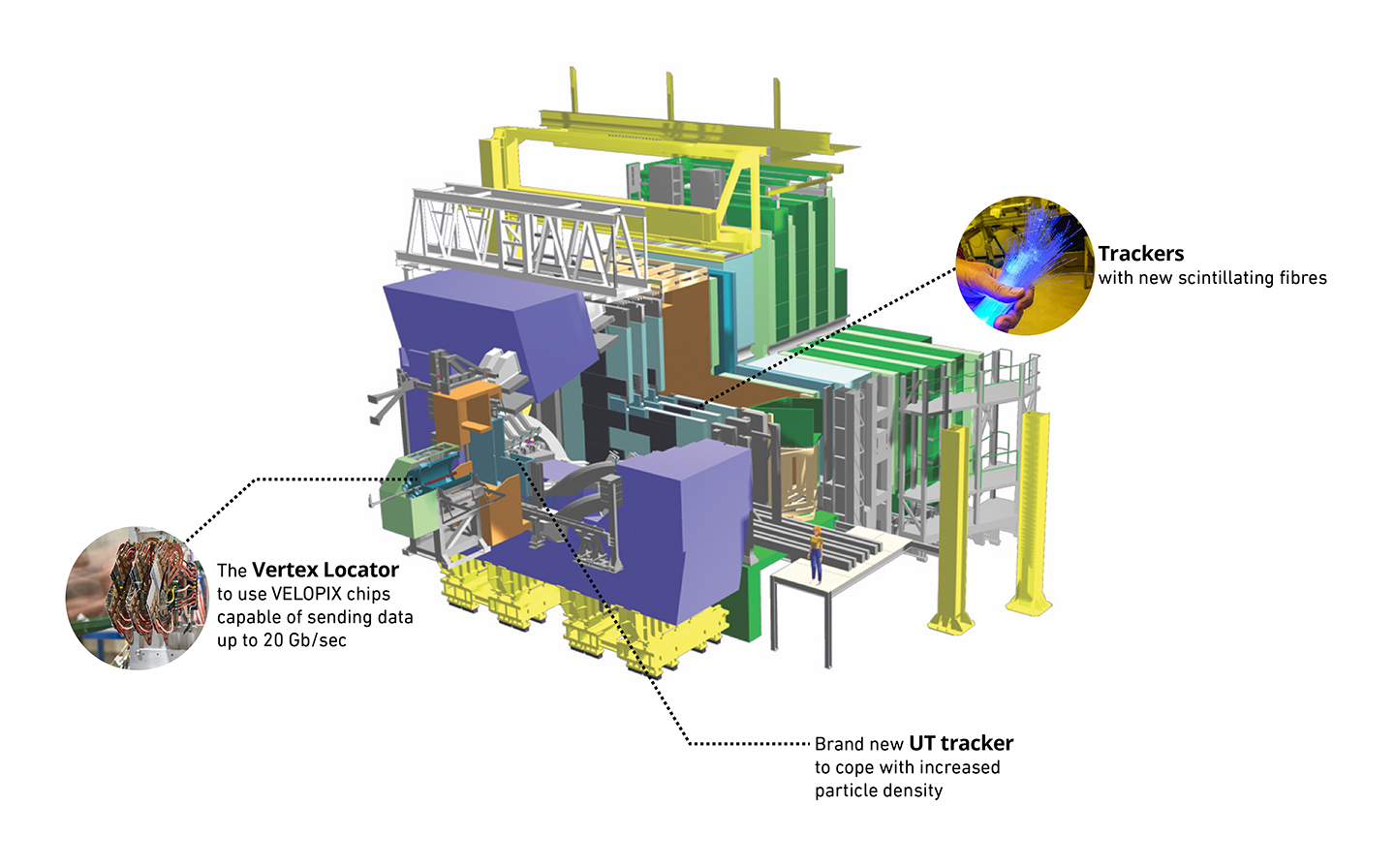The LHCb experiment will undergo a metamorphosis over the coming two years, during CERN’s maintenance and upgrade period known as Long Shutdown 2 (LS2). When the Large Hadron Collider (LHC) restarts in 2021, the proton–proton collision rate at LHCb will be increased by a factor of five, and the collaboration is upgrading its detector to be ready for it.
The LHCb experiment is trying to solve the mystery of why nature prefers matter over antimatter: small asymmetries between the two could explain why matter emerged from the aftermath of the Big Bang while antimatter did not. In particular, LHCb is hunting for beauty or bottom (b) quarks, which were common at the infancy of the Universe and can be generated in their billions by the LHC, along with their antimatter counterparts, beauty antiquarks.
Forty is better than one
As every second of the LHC corresponds to several million proton–proton collisions, a detector’s trigger system needs to decide which data are important to keep and which can be discarded.
Within the LHC, bunches of protons travel in two beams, clockwise and anticlockwise, at almost the speed of light. The beams cross one another in a detector every 25 nanoseconds, corresponding to a frequency of 40 MHz (40 million times per second). In previous years, LHCb filtered down this “event rate” to 1 MHz, using fast electronics to select the most interesting events. Those events were then processed and sifted further. But from 2021 onwards, this will change radically: the whole detector will read at the full rate of 40 MHz to allow event selection to be done more precisely and flexibly by the software. For this reason, the electronics of essentially all the subdetectors will be modified and the computing power of the LHCb event selection system (trigger) will become more powerful.
Flowing at an immense rate of 4 terabytes per second, data will travel from the underground hall, straight from the detector electronics, via some 9000 300-metre-long optical fibres, into a new computer centre that is nearing completion. There, around 500 powerful custom-made boards will receive and transfer data to thousands of processing cores.

A faster VELO
The vertex locator (VELO) – the subdetector that measures the distance between the collision point and the point where B hadrons (composite particles containing at least one b quark or antiquark) transform into other particles – is one of the key components being upgraded during LS2. The new VELO consists of pixel tracking layers, which offer improved hit resolution and simpler track reconstruction. It will also be closer to the beam axis: 5.1 mm as opposed to 8.4 mm. A new chip, the VELOPIX, capable of collecting signal hits from 256×256 pixels and sending data at a staggering rate of up to 20 Gb/s, was developed for this purpose.

Mirror, mirror on the detector
The ring-imaging Cherenkov (RICH) detectors, which determine particles’ identities, will be equipped with a new mirror system. This is required to deflect, focus and detect cones of light emitted by travelling particles in an environment with much larger particle densities.
New silicon-microstrip sensors and SciFi tracking
Currently, the main tracking system reconstructs the path of charged particles in four tracking stations: one between RICH-1 and the LHCb dipole magnet, and three between the magnet and RICH-2. In the future, a new upstream tracker (UT) with innovative silicon-microstrip sensors will be installed in place of the station before the magnet. The three tracking stations after the magnet will be replaced by a new type of station based on scintillating fibres (SciFi), read out at one extremity by silicon photomultiplier (SiPM) arrays.
The SciFi tracker represents a major challenge for the collaboration, not only due to its complexity, but also because the technology has never been used for such a large area in such a radiation environment. Scientists ordered more than 11 000 km of fibre, which they meticulously verified and even cured of a few rare and local imperfections.

With the planned higher luminosity and a greatly improved ability to pick the most interesting events, the transformed LHCb can look forward to unprecedented results in the future.
Read more in “LHCb’s momentous metamorphosis” in the latest CERN Courier, which also has LS2 highlights from ALICE, ATLAS and CMS.
More photos from LHCb are available on CDS:
